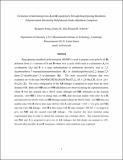Formation of Alternating trans-A-alt-B Copolymers through Ring-Opening Metathesis Polymerization Initiated by Molybdenum Imido Alkylidene Complexes
Author(s)
Jeong, Hyangsoo; John, Jeremy M; Schrock, Richard Royce
DownloadSchrock_Formation of with SI.pdf (3.251Mb)
PUBLISHER_POLICY
Publisher Policy
Article is made available in accordance with the publisher's policy and may be subject to US copyright law. Please refer to the publisher's site for terms of use.
Terms of use
Metadata
Show full item recordAbstract
Ring-opening metathesis polymerization (ROMP) is used to prepare trans-poly(A-alt-B) polymers from a 1:1 mixture of A and B where A is a cyclic olefin such as cyclooctene (A[subscript 1]) or cycloheptene (A[subscript 2]) and B is a large norbornadiene or norbornene derivative such as 2,3-dicarbomethoxy-7-isopropylidenenorbornadiene (B[subscript 1]) or dimethylspirobicyclo[2.2.1]hepta-2,5-diene-2,3-dicarboxylate-7,1'cyclopropane (B[subscript 2]). The most successful initiators that were
examined are of the type Mo(NR)(CHCMe[subscript 2]Ph)[OCMe(CF[subscript 3])[subscript 2]][subscript 2] (R = 2,6-Me[subscript 2]C[subscript 6]H[subscript 3] (1) or 2,6-iPr[subscript 2]C[subscript 6]H[subscript 3] (2)). The trans configuration of the AB linkages is proposed to result from the steric demand of B. Both anti-MB and syn-MB alkylidenes are observed during the copolymerization, where B was last inserted into a Mo=C bond, although anti-MB dominates as the reaction
proceeds. Anti-MB is lower in energy than syn-MB, does not react readily with either A or B, and interconverts slowly with syn-MB through rotation about the Mo=C bond. Syn-MB does not readily react with B, but it does react slowly with A (rate constant ~1 M[superscript -1] s
[superscript -1]) to give anti-MA and one trans-AB linkage. Anti-MA then reacts with B (rate constant ~300 M[superscript -1] s[superscript -1] or larger) to give syn-MB and the second trans-AB linkage. The reaction has been modeled using experimental data in order to obtain the estimated rate constants above. The reaction between anti-MA and A is proposed to give rise to AA linkages, but AA dyads can amount to <5%. Several other possible A and B monomers, initiators, and conditions were explored.
Date issued
2015-10Department
Massachusetts Institute of Technology. Department of ChemistryJournal
Organometallics
Publisher
American Chemical Society (ACS)
Citation
Jeong, Hyangsoo, Jeremy M. John, and Richard R. Schrock. “Formation of Alternating trans-A-alt-B Copolymers through Ring-Opening Metathesis Polymerization Initiated by Molybdenum Imido Alkylidene Complexes.” Organometallics 34.20 (2015): 5136–5145.
Version: Author's final manuscript
ISSN
0276-7333
1520-6041